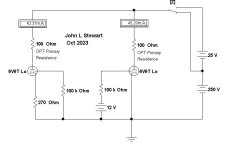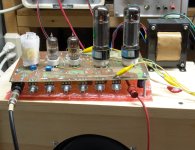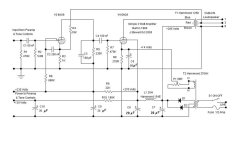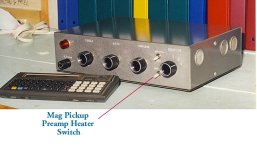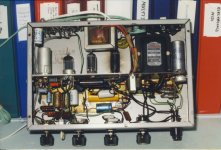Here is the Sim comparing fixed bias to cathode biased operation on well aged 6V6s with the normal cathode emission dropped by 10 %.
The in circuit fixed bias tube emission dropped by ~9.5% while the cathode biased tube plate current dropped by ~4.1%.
Cathode biasing minimizes the need for bias adjustment. And also protects the tube in case of a problem.
Some might wonder where all the Ls, Cs & OPTs went. Biasing is done at DC, all the reactive components don't do much at DC.
And at DC the power pentodes look like triodes for biasing, even when the plate voltage is higher than the screen.
The important number is the screen voltage for biasing calcs. In a good pentode plate current doesn't change much.
Thats where screen curves are more useful than grid curves on the plate family graph. But watch the plate watts.
Not many tubes have that published but there are workarounds. Refer to the GE spec sheet p5 for data on screen vs the plate family
Sure beats shot gunning the design & hoping something good will come out! With one exception I've never used battery bias.
And my PP 815 red plated as the battery eventually sagged. Long ago, when I still had hair,😱
There is a highly detailed data sheet here by AWV (Amalgamated Wireless Valve) of Australia covering the 6J7-G.
The extra data pulled out by AWV on some tubes is very useful.👍
The in circuit fixed bias tube emission dropped by ~9.5% while the cathode biased tube plate current dropped by ~4.1%.
Cathode biasing minimizes the need for bias adjustment. And also protects the tube in case of a problem.
Some might wonder where all the Ls, Cs & OPTs went. Biasing is done at DC, all the reactive components don't do much at DC.
And at DC the power pentodes look like triodes for biasing, even when the plate voltage is higher than the screen.
The important number is the screen voltage for biasing calcs. In a good pentode plate current doesn't change much.
Thats where screen curves are more useful than grid curves on the plate family graph. But watch the plate watts.
Not many tubes have that published but there are workarounds. Refer to the GE spec sheet p5 for data on screen vs the plate family
Sure beats shot gunning the design & hoping something good will come out! With one exception I've never used battery bias.
And my PP 815 red plated as the battery eventually sagged. Long ago, when I still had hair,😱
There is a highly detailed data sheet here by AWV (Amalgamated Wireless Valve) of Australia covering the 6J7-G.
The extra data pulled out by AWV on some tubes is very useful.👍
Attachments
Tubelab_com,
I always like your posts.
And, thanks for helping me make a joke:
You said: "The Mu of the UCC85 tube is 46 or 50 depending on which data sheet you have."
So, now we have vacuum tubes that read your various data sheets. :^)
I always like your posts.
And, thanks for helping me make a joke:
You said: "The Mu of the UCC85 tube is 46 or 50 depending on which data sheet you have."
So, now we have vacuum tubes that read your various data sheets. :^)
For sure that UL84 is a very different beast than the EL84.Just remember that the UL84 is NOT a EL84/6BQ5 with a 45 volt 100 mA heater.
EL84 has a triode mu of ~19.5 while the UL 84 triode mu is ~8. The UL84 should have its own unique number.
It fits in well for low B+ designs. Very similar to the 50L6 / 25L6 / 12L6 / 6W6 family. 👍
Yes, it was unfortunate naming.For sure that UL84 is a very different beast than the EL84.
The UL84 is a 100mA series string version of the EL86; the PL84 is the 300mA version.
There are some similar misnomers in the US family of tubes too. I found out when I was young that a 12L6 is NOT a 12 volt 6L6 though they have the same pinout. The 12L6 is a 12 volt 6W6 as is the 25L6 and 50L6. There were a few 25W6GT's made but most bear the dual 25L6/25W6 markings. The 35L6 is very similar, but not the same as the rest of the series. It came about when AM/FM radios appeared and required two more tubes in the series heater string. The 35L6 is the same tube with a 35 volt 150 mA heater. This makes for a wimpy cathode so the 35L6 can't be hammered as hard as the 50L6 or its brethren. Then there is the 1L6, no it's not a shrunken 6L6 or 6W6, it's a pentagrid RF to IF converter tube used in Zenith Transoceanic battery operated radios. They are somewhat rare and expensive today. In a similar vein, the 35C5 is a wimpy 50C5 which is a 7 pin miniature version of the 50L6. I have a push pull guitar amp that squeezes 20 watts from a pair of 50C5's on 340 volts. A 35C5 will melt if you try to use them due to much higher voltage drop as you try to saturate the tube.For sure that UL84 is a very different beast than the EL84.
EL84 has a triode mu of ~19.5 while the UL 84 triode mu is ~8. The UL84 should have its own unique number.
It fits in well for low B+ designs. Very similar to the 50L6 / 25L6 / 12L6 / 6W6 family. 👍
Standards are such a wonderful thing, everybody has their own standard.
. . . Including naming standards!
RS-232 was a serial interface 'standard'.
5V or 15V
Software handshaking
Hardware handshaking
Software Plus Hardware handshaking.
Only 3 wires; Only 5 wires, . . . etc.
A Real Serious standard (RS), done 232 ways (232) = RS-232
Some KT88 tubes connect pin 1 to the outside metal shield at the base of the tube.
Some KT88 tubes do Not have that connection.
I have seen 13", 14", and 15" wheels.
Why aren't there 14.5" wheels? (a great compromise between 14" wheels and 15" wheels).
Standards!
. . . Including naming standards!
RS-232 was a serial interface 'standard'.
5V or 15V
Software handshaking
Hardware handshaking
Software Plus Hardware handshaking.
Only 3 wires; Only 5 wires, . . . etc.
A Real Serious standard (RS), done 232 ways (232) = RS-232
Some KT88 tubes connect pin 1 to the outside metal shield at the base of the tube.
Some KT88 tubes do Not have that connection.
I have seen 13", 14", and 15" wheels.
Why aren't there 14.5" wheels? (a great compromise between 14" wheels and 15" wheels).
Standards!
Thanks for that reply. If my understanding is correct, over a "whole amp" (from the output's plate to the input grid) this would imply quite a big voltage division ratio, say some 400:1. This excellent website https://www.valvewizard.co.uk/localfeedback.html 🙂 explains the implications of this type of feedback, and one would be that with a 400:1 ratio, a "normal" input impedance of say 10k would imply a 4M feedback resistor, which is a lot, so probably not really feasible? OTOH, I already used this feedback (anode follower) in output pentodes with a voltage ratio of about 10:1.You would have to use shunt feedback, applying feedback to the grid, like an inverting opamp configuration. It's not really an issue though, feedback to cathode still gives you most of the distortion reducing effect you would expect.
Note that over two (or any even number) stages, this is positive, rather than negative, feedback.over a "whole amp" (from the output's plate to the input grid)
All good fortune,
Chris
It's amazing how a single forum post can spark up some old and long forgotten memories of stuff I did in the past. Mention of the UL84 tube by Bondini in post #44 reminded me of how I obtained a box full of 6CW5 tubes maybe 25 years ago by stripping a bunch of old HP 200CD audio oscillators for parts. Somehow a pair of those got stuck into an EL84 / 6BQ5 amp to see what would happen, and it wasn't pretty. I mentioned that fact in post #54 and referenced a series heater string guitar amp I had built for the Hundred Buck Amp Challenge thread 12 years ago. I built two complete amps for that challenge, both series heater string designs that used an isolation transformer for power. I even posted some pictures of that amp that are still on my hard drive. I did not give it much thought until I got a request for the schematic. in post #58. It took a bit of digging to find that schematic since I could not remember what I called it. I found it in my Eagle directory, posted it, done.........
I found myself answering a post in the instruments and amps forum about a very simplified guitar amp. I had breadboarded such an amp a very long time ago. The schematic was simple but I didn't remember the component values. Maybe it's time to dig through the "box of broken dreams" where dead projects go to be mined for parts as needed. I did not find the simple 6AU6 - 6AQ5 guitar amp, but I did find a third amp that was started for the HBAC, but never made the cut since I couldn't get the cost below $100 even with some $1 TV sweep tubes. That project died abruptly when all of the 50JY6's disappeared overnight. No $1 sweep tubes, no need for the octal amp board. It hit the "box" while the 9 pin version went on to be a real guitar amp.
Now that I have the 12 year old PC board in my hands I remember hacking it up to run 6 volt tubes and stuffed some EL34's into it. I think it wound up in the "box" when my job at Motorola ended and we had to start packing for a big move in 2014.
I have now found the Eagle directory and ONE picture. Will this be enough to bring this old relic back to life? If so, I'll start a thread in the instruments and amps forum or wake up the old HBAC thread.
I found myself answering a post in the instruments and amps forum about a very simplified guitar amp. I had breadboarded such an amp a very long time ago. The schematic was simple but I didn't remember the component values. Maybe it's time to dig through the "box of broken dreams" where dead projects go to be mined for parts as needed. I did not find the simple 6AU6 - 6AQ5 guitar amp, but I did find a third amp that was started for the HBAC, but never made the cut since I couldn't get the cost below $100 even with some $1 TV sweep tubes. That project died abruptly when all of the 50JY6's disappeared overnight. No $1 sweep tubes, no need for the octal amp board. It hit the "box" while the 9 pin version went on to be a real guitar amp.
Now that I have the 12 year old PC board in my hands I remember hacking it up to run 6 volt tubes and stuffed some EL34's into it. I think it wound up in the "box" when my job at Motorola ended and we had to start packing for a big move in 2014.
I have now found the Eagle directory and ONE picture. Will this be enough to bring this old relic back to life? If so, I'll start a thread in the instruments and amps forum or wake up the old HBAC thread.
Attachments
I modified an old radio about 40 yrs ago that had PP 35L6s.The 35L6 is the same tube with a 35 volt 150 mA heater.
When it was zipped up with a better phase inverter & a Hammond 125D OPT
it managed 6W audio with a 170V B+ PS. And a much better DF, 👍
Somewhere in this thread an SE amp of 6AU6/6AQ5 was mentioned.
Here is mine from 1968, a complete amp with PS, Baxandall Tone Controls & a front end for mike or GE VR Reluctance phono vinyl pickup.
ALL jammed inside a Hammond 8x12x3 chassis, There are ventilating holes on the bottom & sides.
The front end 12AX7 heater can be shut down when not in use.
The calculator is an HP 71B, it runs in BASIC, 👍
Here is mine from 1968, a complete amp with PS, Baxandall Tone Controls & a front end for mike or GE VR Reluctance phono vinyl pickup.
ALL jammed inside a Hammond 8x12x3 chassis, There are ventilating holes on the bottom & sides.
The front end 12AX7 heater can be shut down when not in use.
The calculator is an HP 71B, it runs in BASIC, 👍
Attachments
Sometimes we can see a schematic with UL taps not used for the ouput stage but for feeding the plate of the driver stage (through the anode resistor).
Sometimes it's "crossed".
It is feedback too, right?
Sometimes it's "crossed".
It is feedback too, right?
I think you are referring to what is called e-linear? I know of an example by Pete Millet, but it is single endedSometimes we can see a schematic with UL taps not used for the ouput stage but for feeding the plate of the driver stage (through the anode resistor).
Sometimes it's "crossed".
It is feedback too, right?
http://www.pmillett.com/elinear.htm
@Bandersnatch did write about it here at Diyaudio. It is indeed negative feedback yes, Crosscoupling to keep the phase?
Simply NFB by Schade by a ratio determined by the tap on the UL OPT.I think you are referring to what is called e-linear? I know of an example by Pete Millet, but it is single ended
Cross coupling normally needs a PP amp to work, It is positive FB which increases the apparent resistance of the plate resister it is attached to.@Bandersnatch did write about it here at Diyaudio. It is indeed negative feedback yes, Crosscoupling to keep the phase?
And it is used to boost the drive to a difficelt output stage, Such as UL, Circlotron & the system used by Electrovoice.
I've used it in all PP cases where gain of the output stage is low. Such as PP 6AS7 / 6080 with mu of 2.
Norman Crowhurst wrote a very good article covering this. And the projects I built were all published in Glass Audio & AudioXpress
about 20 yrs ago. And they have all appeared here on DIY. 👍
🙂
There is a thread in the instruments and amps forum where the OP asked about a minimalist guitar amp that used a 6AU6, 6AQ5 and a 6X4. His circuit was missing a few vital parts, so I mentioned them, and posted the schematic for the 5C1 Fender Champ which used a 6SJ7, a 6V6 and a 5Y3. I breadboarded an amp similar to the Champ with a 6AU6 and a 6AQ5, went looking for the old breadboard so I could fetch the parts values, but could not find it.Somewhere in this thread an SE amp of 6AU6/6AQ5 was mentioned.
https://www.diyaudio.com/community/threads/6au6-6aq5-6x4-amp.404812/#post-7497168
- Home
- Amplifiers
- Tubes / Valves
- Single ended pentode with plate-to-cathode feedback
